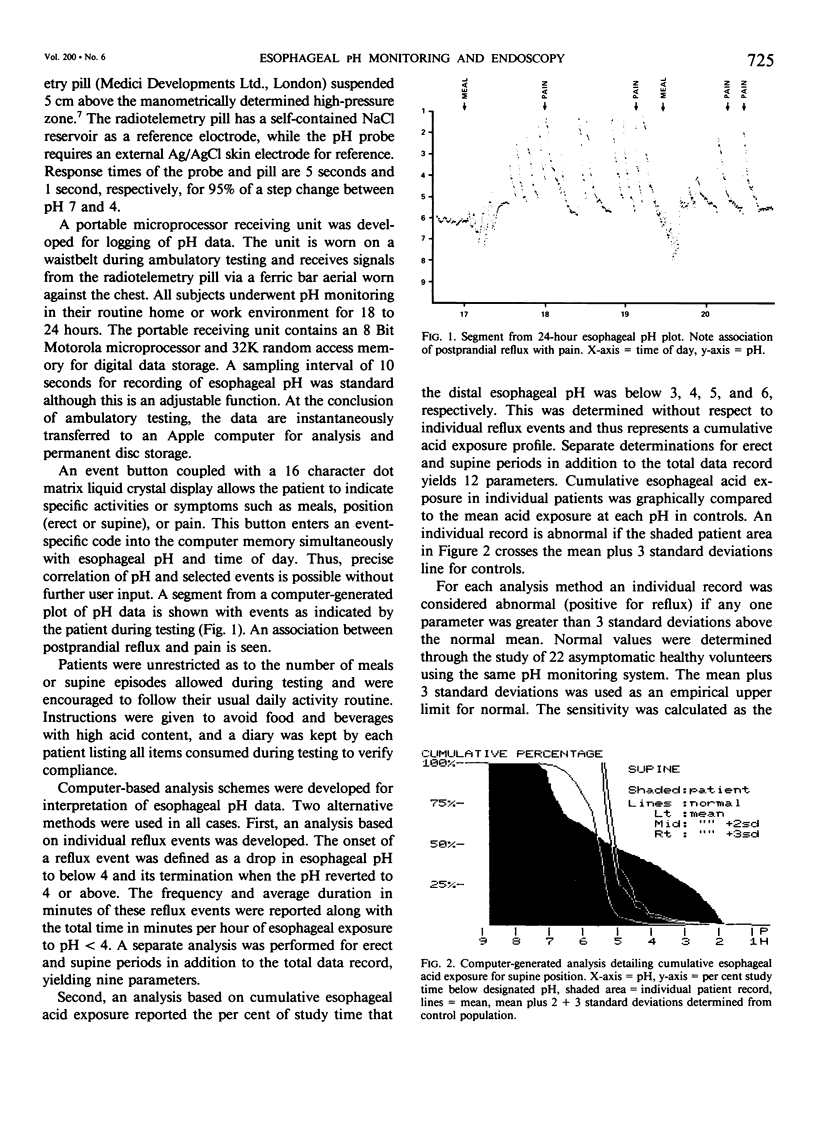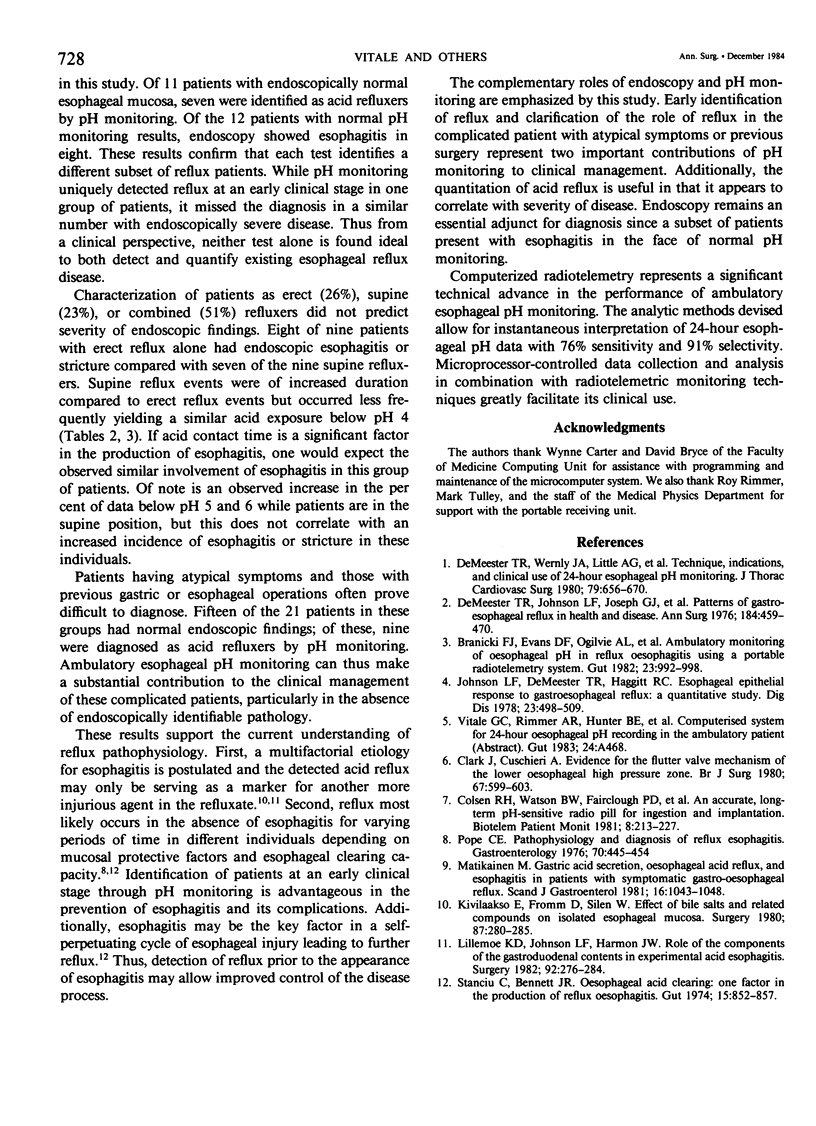Abstract
Ambulatory 24-hour esophageal pH monitoring and esophagogastroduodenoscopy were performed in 72 patients with symptoms suggestive of gastroesophageal reflux. Additionally, 22 asymptomatic healthy volunteers underwent pH monitoring. In patients with classic reflux symptoms and endoscopic esophagitis, a mean of 5.41 minutes/hour of reflux below pH 4 was found compared to 0.70 minutes/hour in controls (p less than 0.0001). The mean number and duration of reflux events in this group were 1.51 events/hour and 4.0 minutes/event, compared with 0.31 events/hour and 2.26 minutes/event in volunteers (p less than 0.001, p less than 0.01). A new system for ambulatory esophageal pH monitoring is presented using a pH-sensitive radiotelemetry pill or a pH probe and computerized methods for ambulatory data collection, analysis, and storage. An overall sensitivity of 76% was obtained with a 91% selectivity for detection of acid reflux in 51 patients having classic symptoms of gastroesophageal reflux. Ambulatory pH monitoring was positive for acid reflux in seven of 11 patients with normal endoscopic findings. Conversely, eight of 12 patients with normal pH monitoring had endoscopic esophagitis. In 19 patients presenting with atypical symptoms or previous gastric surgery, endoscopic findings were normal in 15. Nine of these 15 were identified as acid refluxers by pH monitoring. A combined approach using both pH monitoring and endoscopy is warranted for maximal detection and quantification of disease. A clear clinical role for pH monitoring is seen in the early diagnosis of acid reflux, particularly in patients having normal endoscopic findings with nonspecific gastrointestinal complaints or previous gastric operations.
Full text
PDF




Selected References
These references are in PubMed. This may not be the complete list of references from this article.
- Branicki F. J., Evans D. F., Ogilvie A. L., Atkinson M., Hardcastle J. D. Ambulatory monitoring of oesophageal pH in reflux oesophagitis using a portable radiotelemetry system. Gut. 1982 Nov;23(11):992–998. doi: 10.1136/gut.23.11.992. [DOI] [PMC free article] [PubMed] [Google Scholar]
- Clark J., Cuschieri A. Evidence for the flutter valve mechanism of the lower oesophageal high pressure zone. Br J Surg. 1980 Aug;67(8):599–603. doi: 10.1002/bjs.1800670823. [DOI] [PubMed] [Google Scholar]
- Colson R. H., Watson B. W., Fairclough P. D., Walker-Smith J. A., Campbell C. A., Bellamy D., Hinsull S. M. An accurate, long-term, pH-sensitive radio pill for ingestion and implantation. Biotelem Patient Monit. 1981;8(4):213–227. [PubMed] [Google Scholar]
- DeMeester T. R., Wang C. I., Wernly J. A., Pellegrini C. A., Little A. G., Klementschitsch P., Bermudez G., Johnson L. F., Skinner D. B. Technique, indications, and clinical use of 24 hour esophageal pH monitoring. J Thorac Cardiovasc Surg. 1980 May;79(5):656–670. [PubMed] [Google Scholar]
- Demeester T. R., Johnson L. F., Joseph G. J., Toscano M. S., Hall A. W., Skinner D. B. Patterns of gastroesophageal reflux in health and disease. Ann Surg. 1976 Oct;184(4):459–470. doi: 10.1097/00000658-197610000-00009. [DOI] [PMC free article] [PubMed] [Google Scholar]
- Johnson L. F., Demeester T. R., Haggitt R. C. Esophageal epithelial response to gastroesophageal reflux. A quantitative study. Am J Dig Dis. 1978 Jun;23(6):498–509. doi: 10.1007/BF01072693. [DOI] [PubMed] [Google Scholar]
- Kivilaakso E., Fromm D., Silen W. Effect of bile salts and related compounds on isolated esophageal mucosa. Surgery. 1980 Mar;87(3):280–285. [PubMed] [Google Scholar]
- Lillemoe K. D., Johnson L. F., Harmon J. W. Role of the components of the gastroduodenal contents in experimental acid esophagitis. Surgery. 1982 Aug;92(2):276–284. [PubMed] [Google Scholar]
- Matikainen M. Gastric acid secretion, oesophageal acid reflux, and oesophagitis in patients with symptomatic gastro-oesophageal reflux. Scand J Gastroenterol. 1981;16(8):1043–1048. doi: 10.3109/00365528109181026. [DOI] [PubMed] [Google Scholar]
- Pope C. E., 2nd Pathophysiology and diagnosis of reflux esophagitis. Gastroenterology. 1976 Mar;70(3):445–454. [PubMed] [Google Scholar]
- Stanciu C., Bennett J. R. Oesophageal acid clearing: one factor in the production of reflux oesophagitis. Gut. 1974 Nov;15(11):852–857. doi: 10.1136/gut.15.11.852. [DOI] [PMC free article] [PubMed] [Google Scholar]


